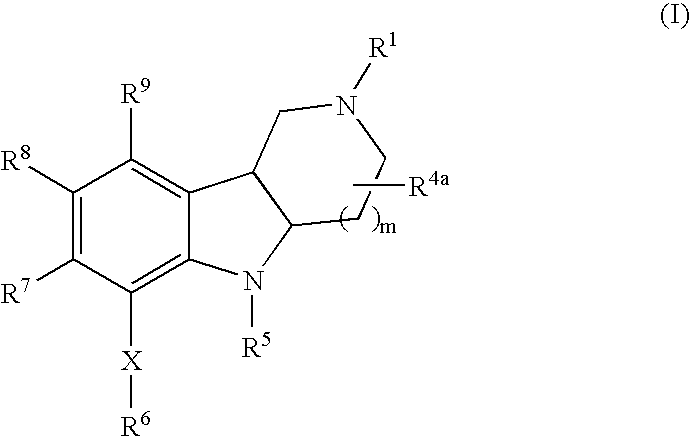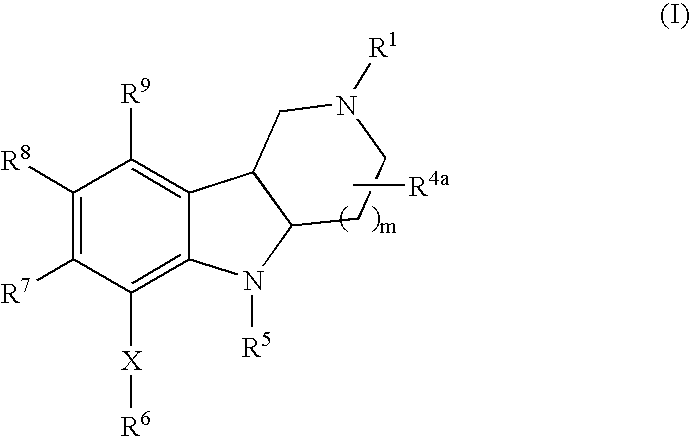Substituted hexahydro-pyridoindole derivatives as serotonin receptor agonists and antagonists
a technology of serotonin receptor and substituted hexahydropyridoindole, which is applied in the direction of biocide, drug composition, metabolic disorder, etc., can solve the problems of detracting from the efficacy of front-line treatment in schizophrenia and related disorders, suffering from delayed onset of action, and side effects of treatmen
- Summary
- Abstract
- Description
- Claims
- Application Information
AI Technical Summary
Problems solved by technology
Method used
Image
Examples
example 1
Preparation of trans-(4a,9b)-2-methyl-2,3,4,4a,5,9b-hexahydro-1H-pyrido[4,3-b]indol-6-yl-4-methylphenyl sulfide
[0090] Step A. 2-Tolylsulfanylaniline (2.15 g, 10 mmol) was suspended in conc. HCl (1-3 mL). This mixture was cooled in an ice bath. An aqueous solution (6.5 mL) of NaNO2 (0.7 g, 10 mmol) was added dropwise over 6 min (internal temp 2 (3.8 g, 20 mmol) in conc. HCl (4.5 mL) over 10 min. The cooling bath was removed and the reaction mixture was maintained at 0° C. for 20 min and at rt for 1.5 h. Solid product was collected by vacuum filtration, washed with 1N HCl, and dried under vacuum at rt for 18 h to afford 1-{2-[(4-methylphenyl)sulfanyl] phenyl}hydrazine hydrochloride (2.09 g, 78%) as a yellow powder. 1H NMR (300 MHz, CDCl3) δ 7.42 (t, J=8.1 Hz, 2H), 7.10 (s, 4H), 7.03 (t, J=7.3, 2H), 2.26 (s, 3H) ppm.
[0091] Step B. 1-{2-[(4-Methylphenyl)sulfanyl]phenyl}hydrazine hydrochloride (1.67 g, 6.27 mmol) and 4-piperidone monohydrate hydrochloride (963 mg, 6.27 mmol) were suspe...
example 2
Preparation of trans-(4a,9b)-6-[(4-fluorophenyl)sulfanyl]-2-methyl-2,3,4,4a,5,9b-hexahydro-1H-pyrido [4,3-b]indole
[0093] Step A. To a solution of 4-fluorothiophenol (1.0 g, 7.8 mmol) and 2-chloronitrobenzene (1.2 g, 7.8 mmol) in THF (10 mL) at 0° C. was added NaH (60% dispersion in oil, 390 mg, 9.4 mmol). The reaction was brought to room temperature and allowed to stir for 18 h. Ice was added and the layers separated. The aqueous layer was extracted three times with EtOAc (3×50 mL). The combined extracts were washed with water (50 mL) and dried (Na2SO4) and evaporated affording 4-fluorophenyl 2-nitrophenyl sulfide (1.6 g, 82%) as a yellow solid. 1H NMR (CDCl3, 300 MHz) δ 8.24 (dd, 1H, J=1.5, 8 Hz), 7.58-7.63 (m, 2H), 7.38 (dt, 1H, J=1.5, 7.4 Hz), 7.15-7.25 (m, 3H), 6.82 (dd, 1H, J=1.1, 8.1 Hz) ppm.
[0094] Step B. 4-Fluorophenyl-2-nitrophenyl sulfide (1.6 g, 6.4 mmol) was combined with palladium hydroxide (200 mg) in EtOH (100 mL) and stirred for 18 hours under H2 (55 psi). The mixt...
example 3
Preparation of trans-(4a,9b)-6-[(4-chlorophenyl)sulfanyl]-2-methyl-2,3,4,4a,5,9b-hexahydro-1H-pyrido [4,3-b]indole
[0098] Step A. The following compound was prepared in 89% yield by substituting the required thiophenol for 4-chlorothiophenol by the procedure in Example 2, Step A. 1H NMR (CDCl3, 300 MHz): δ 8.23 (dd, 1H, J=1.4, 8 Hz), 7.23-7.48 (m, 4H), 7.36 (dt, 1H, J=1.4, 7.3 Hz), 7.20-7.29 (m, 1H), 6.86 (dd, 1H, J=1.1, 8.1 Hz) ppm.
[0099] Step B. The following compound was prepared in 80% yield by the procedure of Example 2, Step B. 1H NMR (CD3OD, 300 MHz) δ 7.41-7.58 (m, 4H), 7.35 (d, 2H, J=8.4 Hz), 7.23 (d, 2H, J=8.7 Hz) ppm.
Step C. The following compound was prepared in 94% yield according to the procedure for Example 2, Step C. 1H NMR (CD3OD, 300 MHz) δ 7.42-7.55 (m, 2H), 7.25 (d, 2H, J=8.4 Hz), 7.07 (d, 2H, J=8.87 Hz), 7.02-7.10 (m, 2H) ppm.
[0100] Step D. The title compound was prepared by the method of Example 2, step D in 78% yield. 1H NMR (CD3OD, 300 MHz) δ 7.55 (d, 1H,...
PUM
| Property | Measurement | Unit |
|---|---|---|
| pH | aaaaa | aaaaa |
| temperature | aaaaa | aaaaa |
| temperature | aaaaa | aaaaa |
Abstract
Description
Claims
Application Information
 Login to View More
Login to View More - R&D
- Intellectual Property
- Life Sciences
- Materials
- Tech Scout
- Unparalleled Data Quality
- Higher Quality Content
- 60% Fewer Hallucinations
Browse by: Latest US Patents, China's latest patents, Technical Efficacy Thesaurus, Application Domain, Technology Topic, Popular Technical Reports.
© 2025 PatSnap. All rights reserved.Legal|Privacy policy|Modern Slavery Act Transparency Statement|Sitemap|About US| Contact US: help@patsnap.com



